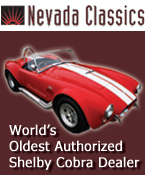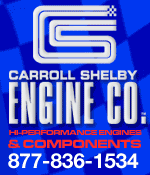 
 Main Menu
Main Menu
|
 Nevada Classics
Nevada Classics
|
 Advertise at CC
Advertise at CC
|
 February 2025
February 2025
|
| S |
M |
T |
W |
T |
F |
S |
| |
|
|
|
|
|
1 |
| 2 |
3 |
4 |
5 |
6 |
7 |
8 |
| 9 |
10 |
11 |
12 |
13 |
14 |
15 |
| 16 |
17 |
18 |
19 |
20 |
21 |
22 |
| 23 |
24 |
25 |
26 |
27 |
28 |
|
|
 CC Advertisers
CC Advertisers
|
|

06-21-2005, 11:09 AM
|
|
Senior Club Cobra Member

|
|
|
Join Date: Jul 2002
Cobra Make, Engine:
Posts: 15,712
|
|

 Not Ranked
Not Ranked
Thanks Brent, interesting!
|
-
Advertising


06-21-2005, 12:36 PM
|
 |
Senior Club Cobra Member

|
|
|
Join Date: Jan 1999
Location: MARKSVILLE,LA.,,
Posts: 3,235
|
|

 Not Ranked
Not Ranked
As far as choke vs. no choke goes,I removed the choke and air horn on both my vac sec holley and the double pumper.......I pump the accelarator twice,hit the starter and she fires up first time,every time,then when the oil pressure comes up to normal,I put it in reverse or first (depends which way I'm heading),let off the clutch,give it just enough gas to keep running and move the car about 1 car length,then bump the shifter into neutral, and the motor will idle nicely no matter how cold it is,just got to put it under a slight load and get it to pull a little vacum to keep it running till it fully warms up.............
David
__________________
DAVID GAGNARD
|

06-21-2005, 06:41 PM
|
|
CC Member

|
|
|
Join Date: Aug 2004
Cobra Make, Engine: ERA 427 #708, 427 SO
Posts: 181
|
|

 Not Ranked
Not Ranked
To all those that suggest a newer technology carb, can you please provide me with the manufacturer AND the specific part/model number. Looks like there is an equal fan base for the Holley as there is for the Barry Grant.
Also would appreciate recs on a specific larger diameter air cleaner element that should fit under the hood. (again make and specific model # please)
Again car is an ERA. Intake is a Blue Thunder dual plane.
CB
|

06-21-2005, 07:07 PM
|
 |
CC Member

|
|
|
Join Date: May 2001
Location: The Heart of the Citrus District,
NJ
Cobra Make, Engine: Sold 3047 & 3002 in 2012
Posts: 2,763
|
|

 Not Ranked
Not Ranked
 Carb
Carb
Go to
www.aedperformance.com
They don't have a catchy name like BG, but they make better performance carbs. Call them for their suggestion. I think they are a cut above the rest. |

06-22-2005, 04:33 AM
|
|
CC Member

|
|
|
Join Date: Mar 2001
Location: E BRUNSWICK N.J. USA,
Posts: 3,841
|
|

 Not Ranked
Not Ranked

cbmax CB I ran your motor through dyno 2000 and dyno slim With the info from the thread I came up with 496hp and 549 tork. Changing carbs to an 830 will give you 6hp and 3 tork lbs. The exhaust is the big restrictor for your motor I got 22 hp and 14 tork with race pipes. A Dove single plane fits under ERA hood with a low or flat aircleaner. Your rpm limit is 5750. your motor falls like a rock after this. Before you start blow alot of coin on intakes and carbs and cams and head work, do the exhaust first. Stick your hand in the tail of your side pipe, you can feel the end of the muffler, is 2 1/4 or 2 1/2 outlet, this is great for cruising but not getting the most out of a motor. I have 2 sets of pipes. There is a formula for carb size, you could run a 650 DP dual feed on you motor, it will limit your rpm to 6500 rpm. Bigger is not always better. I will stay with my first thread about driving the car and many maintainance free miles. If you want to talk 732-254-3536. Going to ERA on Sat for parts. Rick Lake

|

06-22-2005, 06:38 AM
|
|
CC Member

|
|
|
Join Date: Mar 2003
Cobra Make, Engine:
Posts: 1,514
|
|

 Not Ranked
Not Ranked
CBMax - Whether your happy or not really depends on what you intend to do with the car/motor. For street use, primarily, the engine is most likely ideal - very similiar to TC's combo. For the track (road racing) you'll be longing for more as your experience with the car increases but then again you can never have enough so that might happen anyhow. 
If those numbers are at the flywheel I'd even say they seem a little lower than stock - I could be wrong but "real world" estimates of standard 427's were between 460-480 hp and low 500's on torque - just a basis of comparison.
I'd side with most others who suggested breaking the engine in, getting to know your car and it's characteristics, and then deciding on updates/upgrades all around. Sounds like a very nice combo you - enjoy it and be safe! |

06-22-2005, 07:21 AM
|
|
CC Member

|
|
|
Join Date: Feb 2004
Location: Outside Miami,
FL
Cobra Make, Engine: Several
Posts: 949
|
|

 Not Ranked
Not Ranked
Good and sensible advice, all.
Get to know it, read a lot, count each penny, talk with Mr. G, and drive it a lot.
The fun is in the planning and driving, not the spending.
No rush. Enjoy. Read a little Zen. And Jose Silva. Take some rides. Fiddle. Plan. Re-plan. Filter. Decide. Dream. Change your mind.
__________________
"A free people ought not only to be armed and disciplined but they should have sufficient arms and ammunition to maintain a status of independence from any who might attempt to abuse them, which would include their own government."
George Washington
|

06-22-2005, 07:30 AM
|
 |
CC Member

|
|
|
Join Date: Aug 2003
Location: Southeast,
CT
Cobra Make, Engine: ERA #375 427 S/C - 428FE - Toploader - 1968 AMX 390 Go Pack 4 Speed - My Daily Driver is a 2004 Crossfire
Posts: 872
|
|

 Not Ranked
Not Ranked
CB:
The Demon I am running is a Mighty Demon 750 with down leg boosters. It has mechanical secondaries, float bowl sight glasses, and streamlined air entries. This is the Barry Grant version of the classic Holley Double Pumper however the actual equivalent IMHO from Holley is the 4150 HP PRO Series 750. This carb is very much like the Mighty Demon 750 as it does not have the air horn stack.
I purchased my Demon from FBO Systems and would do so again in a heartbeat... super folks... super support... nice nice nice experience all around.
http://www.4secondsflat.com/
BTW, just what is the "primary" use that you are going to utilize the ERA for anyhow??
Cruising?
Dragging?
Road Racing?
Autocrossing?
__________________
Art in CT
See My Website at http://www.lithicsnet.com
A car can massage organs which no masseur can reach. It is the one remedy for the disorders of the great sympathetic nervous system. Jean Cocteau 1889-1963, French Author, Filmmaker
Last edited by REDSC400; 06-22-2005 at 03:10 PM..
|

06-22-2005, 08:02 AM
|
|
CC Member

|
|
|
Join Date: Feb 2005
Location: East Haddam,
CT
Cobra Make, Engine: FFR 3881 427 FE w/2x4bbls and 4 spd toploader
Posts: 119
|
|

 Not Ranked
Not Ranked
 Re: Genesis 427 S/O- First Dyno Pull
Re: Genesis 427 S/O- First Dyno Pull
Quote:
Originally posted by cbmax
Just got the initial dyno results back from Joe Lapine at Danbury Competition Engine.
Joe reports 470HP at 5800 RPMS first pull. This was through street legal mufflers, water pump attached and I believe no filter on the carb. He only did one dyno run. He said the weather was rainy and humid and not the best day for making power.
Looks like compression ratio is 10.68 to 1.
Motor has:
Genesis iron block
Bore 4.252
Stroke 4.125
Rod length 6.7
Scatz 4 1/8 crank
Scatz 6.7 H-Beam Rods
Edelbrock alumunium intake manifold and heads with basic port work
Aviaid competition oil pan
Comp cam (solid) 33-246-4
Holley 3310 750CFM Carb
Edelbrock water pump
Wiseco pistons
This is the all the details I have at this point.
So, will I be impressed?
Was hoping for 500 HP. (not sure why, just bragging rights I guess)
Do you think motor will improve with break in? How about when motor is run through open headers when it is installed in my ERA cobra?
What type of performance on the street should I expect?
Thanks for you input!
CB
|

|

06-22-2005, 08:37 AM
|
|
CC Member

|
|
|
Join Date: Feb 2005
Location: East Haddam,
CT
Cobra Make, Engine: FFR 3881 427 FE w/2x4bbls and 4 spd toploader
Posts: 119
|
|

 Not Ranked
Not Ranked
 DCE engines
DCE engines
Joe just finished rebuilding my '64 427 FE engine about two months ago. Dyno time was not available as Jeff next door was back logged with the dyno. If I told any of my motor head friends that the car is making 750HP none after a ride would argue. Unless you plan on letting your car sit in a trailer to be raced only, Joe's creation in your ERA will most likely scare you to death! Save your money, pick a HP number you like and remember that the only thing you will have trouble passing will be a gas station. My engine is .30 over and stroked using the Ford SC 428 crank, Edelbrock 76cc heads, stock 425hp Ford cam, Blue Thunder dual 4bbl intake with Holley 500cfm carbs and Canton oil pan. It starts right away, idels at 850rpm, hasn't leaked a drop of oil, stays cool and will pull your face back twenty years! Best of luck. You choose one of the best FE engine builder around.
RB |

06-22-2005, 08:51 AM
|
 |
Senior Club Cobra Member

|
|
|
Join Date: Jun 2003
Location: West Linn,
OR
Cobra Make, Engine: ERA #684, 428 FE, TKO600
Posts: 1,378
|
|

 Not Ranked
Not Ranked

CB:
Don't get overly wrapped up in dyno numbers at this point. Keep in mind that the only thing a dyno number means is that at the time it was taken with the engine fitted with certain components on this particular dyno and the weather outside being such and so you have this number as a base line.
Dyno results will vary quite a bit depending on what's on the engine. Water pump? Probably good for about 15 HP. Street mufflers? Probably good for about 40 HP. No air filter? Probably good for about 20 to 30 HP. This particular dyno calibration compared to someone elses dyno? Variations of probably up to 10%.
For the experts reading this I said PROBABLY. Your result may vary.
The point I'm trying to make is that a dyno number shouldn't be seriously looked at as anything more than a reference point to see how whatever changes you've made effect the efficiency of the engine providing subsequent runs are made on the same dyno.
As previously stated, run the car, have fun with it, think or dream about what you'd do to change it (my dreams are filled with IR EFI from Very Cool Parts which I may or may not get to this winter), change your mind about what you want to do to it and then, after a few thousand miles of driving, reconsider it all again. It gives you something to do on the long straightaways between stop lights or corners.
The idea is to enjoy the car and not take it too seriously.
DonC

|

06-22-2005, 09:12 AM
|
 |
Senior Club Cobra Member

|
|
|
Join Date: Feb 2000
Location: Midland Park,
NJ
Cobra Make, Engine: ERA 389 427s/o
Posts: 1,247
|
|

 Not Ranked
Not Ranked
Save the money for the gas stations.
Enjoy the car and don't worry about dyno #'s. If not tracking the car it will be only the rare occurence you will push the car near its limits.
It is not like we have the equivilent of Death Vally or the wide open roads of the west around NJ to find the limits in any reasonable safe way.
jmho
JW
|

06-22-2005, 09:21 AM
|
|
CC Member

|
|
|
Join Date: Dec 2001
Location: Yorba Linda,
ca
Cobra Make, Engine: B&B non-donor, 496 Genesis SO (608 HPwith 9.4:1 CR), Tremec TKO, Currier 8.8
Posts: 187
|
|

 Not Ranked
Not Ranked
I was chuckling the other day when I saw a Cobra trying to impress the gathered crowd. The road was crowned a bit so he couldn't get on it. After a couple of tentative stabs on the throttle, he decided to go way up on to the highway to get on it - about 1/4 mile away. By then, nobody cared any more.
He probably should have passed around copies of his dyno sheet. I, for one,would have been more impressed with his $22,00.00 engine. 
Brian |

06-22-2005, 03:40 PM
|
 |
Senior Club Cobra Member

|
|
|
Join Date: Mar 2002
Location: God's country,
ME
Cobra Make, Engine: Original ERA 427sc, Powered by Gessford
Posts: 2,678
|
|

 Not Ranked
Not Ranked

CB-
I think you will be pretty happy with that motor- it sounds like a good solid street motor with more than enough hp/torque to scare the crap out of you.
But I would highly suggest that you ditch the holley 3310. I was always a believer in vacuum secondary carbs (and still am for other applications) and I had that same carb on my motor originally and I never could get it to run right. I changed the springs in the secondaries, changed the cams on the accelerator pump, changed primary jets, changed the sizes of the discharge nozzle, etc., and no matter what I did it just wouldn't run right.
Eventually I bought a mighty demon 750 (I also bought it from Don at 4seconds flat and would recommend him in a heartbeat) and the car ran infinitely better right out of the box. I was pleased.
Later, I put it on a chassis dyno and, by playing with the timing a little bit and changing the jets, I picked up 43 hp and 21 ft/lbs of torque at the rear wheels. Driving back from the dyno the car ran noticeably better.
To make a long story short, ditch the 3310, get the demon and once the motor is broken in, get it tuned on a chassis dyno and I am sure you will be very happy with that motor. (That is until you decide you want webers, EFI or something else  )
__________________
Replica is not a dirty word.
"If you can't be a good example, then you'll just have to be a horrible warning."
|

06-22-2005, 04:27 PM
|
|
CC Member

|
|
|
Join Date: Dec 2001
Location: Yorba Linda,
ca
Cobra Make, Engine: B&B non-donor, 496 Genesis SO (608 HPwith 9.4:1 CR), Tremec TKO, Currier 8.8
Posts: 187
|
|

 Not Ranked
Not Ranked
CB,
Was that a chassis dyno (rear wheels) or a crankshaft dyno? I think the responses are all assuming an engine dyno.
Brian
|

06-22-2005, 04:49 PM
|
|
CC Member

|
|
|
Join Date: Nov 2004
Location: Hillsboro,
OR
Cobra Make, Engine: ERA 541, Shelby 427, TKO600
Posts: 59
|
|

 Not Ranked
Not Ranked

Sort of a timely thread for me, both on cam and carb. I originally had a shelby built and dyno'd 427 (their aluminum block, heads, intake) that dyno'd at 500 HP at 6000 rpm with mufflers, h20 pump, etc. That was stock 427 stroke, 4.25 bore. The heads and intake are ported. The cam was a way radical comp hydraulic with 260/260 deg @ 0.050"and .611" lift. The Carb was a "carb shop" tweaked 3310 with secondary meetering plate. The car was scary fast above 3500 rpm but not very streetable. Also the carb was not the right carb for that cam and I could not get it running right (turned out part of the problem was a failed intake gasket though).
So I decided to go with a new cam. After quite a bit of research I went with Comp cams new Xtream energy series with 230/236 duration @ 0.050". Was told that it had fast ramps for better throttle response, yada yada. Cam when in and made a huge difference in drivablity of the car. Pulls from 1200rpm on up and the mid range is fantastic. Still scary fast on the top end too, so I am not sure how much I gave up. Only small complaint is that it is a little noisy (valve noise), has to do with the faster ramps. Still not a bad sound.
On the tuning side I tried to make the 3310 work, but gave up and went to see Don Gould (FBO systems) which is local to me. Don is a FANTASTIC GUY. Most of my tuning issues turned out to be timing related which I did not believe but Don proved me wrong! My engine combo loves a ton of initial timing (25 degs). I also make a switch to a mighty demon on Don's advivce. Wow is about all I can say. The throttle response is nothing short of amazing now, good thing the ERA has such a loooong travel throttle pedal or I would be fish tailing all the time :-)
Bottom line to me is not how much total HP you make unless you are going to spend a lot of time on the track. I love the way my car drives now, it is streetable but will still scare the piss out of you when opened up. Never will 450+ HP in 2400lbs be boring.
Good luck with you new ERA, they are great cars.

|

06-22-2005, 08:19 PM
|
|
CC Member

|
|
|
Join Date: Feb 2004
Location: Outside Miami,
FL
Cobra Make, Engine: Several
Posts: 949
|
|

 Not Ranked
Not Ranked

At the risk of being redundant to my own remarks and those of others, i would like to re-iterate a particular feature of both the Holley HP series carbs and some of the Demon carbs (although i don't really know which of the Demon's).
A few years ago the results of considerable experimentation at Holley resulted in a major break-through in venturi design and flow characterists creating the vacuume sensitivity and the increased strength of the vacuume signal used to tell/pull fuel into the airstream.
An electrical engineer might say that the carb now has significantly higher signal gain. A physicist might say the signal circuit had increased Q or ratio accuracy.
This higher signal strength was a very important issue to us rodders, but we didn't know it. With a tiny signal, which occured at very wide throttle openings and low rpms, it wasn't possible on the old carbs to put enough fuel into the very slow moving air mass. Once the rpms increased enough, the air mass flow increased enough to result in a large enough signal to add enough fuel to the air, so the engine ran better. This effect almost always required a vacuume operated secondary on the street, to keep the flow high enough past the venturi(s) on the only two open barrels. It was pretty straightforward enough to set the secondary linkages, vacuume pot sensitivity and diaphragm springs to open the second pair of barrels properly. But, the total hp developed under the two barrels wasn't as high as possible as if they were all open.
And, of course, the vacuume system could hang up (often the cause of serious accidents in the 'Vette 3 X 2bbl set-ups on the first 427's, but don't ask me how i know) and then flip to WOT with a bump in the road. Neither did the engines pull hard off the line, running only the two barrels.
This problem was oh so common to see in the older Holleys, a real pain in the buttinski. You could try to fix it with bigger pumpers, excess richness, etc, but the problem was that the mechanical 'amplifier' in the venturi system was too weak at low air mass flows. So you 'feathered' the throttle open all the time and tried to keep high rpms so you could slam it when necessary. And cold operation was ugly.
When Holley finally decided to get some fluidic people on this, in addition to their regular folks, significant discoveries resulted in much better gain designs, higher signals and more precise control accuracy at a wider range of air mass flows, especially in the dreaded WOT at low rpm region.
So, naturally, other carb companies 'discovered' the same improvements soon enough. OK by me. i still stick with Holley, i guess, because of such a long history of use and the smart applications engineers on the other end of the phone.
i've also found the same throttle response issues in race-boat engines, plus special safety issues, better served by Holley. i see guys out there with their 7 liter hydros and old design carbs, running just as awful as they used to run twenty or thirty years ago. They are simply such poor mechanical amplifiers that too much fiddleing is necessary to get them to work. And SOME of them don't even use center pivot float systems, which means that the float bowls are at the wrong levels. As the props grip, the hard acceleration pushes the fuel to the rear of the bowls and expose the main jets to air-sloshed (and entrained) fuel and they have no extensions from the jets to the rear of the bowl. You don't have to be a genius to fix those problems. But, instead of getting with the program, they suffer with ill-tempered engines, popping and dying and then generating lots of power in the range it will finally work. Painful to watch.
My opinion, sell them (non-HP's) to a collector and go all new. Or keep it in a nice box for the next 'nostalgic' owner of your rig, include it in the sale and for pete's sake don't waste your time and energy trying to make that pig work; unless you are really very, very sharp and can make big time changes correctly.
Now, there are specialists out there that have improved on Holley/Demon designs for even wider ranges of rpm's. And their designs improve the total amount of HP available in a very wide range of rpms, particularly from 3500 to 9000 rpms. These proprietary designs are de riger in NASCAR (and other places); where frequently, you can neither buy or examine the carb in detail, but you rent carbs (and the engineer/tuner that comes tethered to them) only. Hey, if you want the best, it is always much more money because they invested that much R&D/test/set-up time in it and they are not going to let you copy or reverse engineer it. Would you?
However, you might be able to buy one 1-2 years old and don't be surprised at the $3-5K price for a used carb...that might have the proprietary bits in it, but might not have them all and certainly not the latest...
Summary: Holley HP's forever (or at least until i find something better).
My 2¢.
__________________
"A free people ought not only to be armed and disciplined but they should have sufficient arms and ammunition to maintain a status of independence from any who might attempt to abuse them, which would include their own government."
George Washington
Last edited by What'saCobra?; 06-22-2005 at 08:25 PM..
|

06-23-2005, 06:00 AM
|
|
CC Member

|
|
|
Join Date: Apr 1999
Location: cleveland,
OH
Cobra Make, Engine: CSX4000, 427
Posts: 1,999
|
|

 Not Ranked
Not Ranked
What'sa,
just curious, what'sa your opinion regarding the holley HP carbs, the down-leg vs. annular boosters, and the use or non-use of a secondary power valve?
__________________
"After jumping into an early lead, Miles pitted for no reason. He let the entire field go by before re-entering the race. The crowd was jumping up and down as he stunned the Chevrolet drivers by easily passing the entire field to finish second behind MacDonald's other team Cobra. The Corvette people were completely demoralized."
|

06-23-2005, 07:56 AM
|
|
CC Member

|
|
|
Join Date: Feb 2004
Location: Outside Miami,
FL
Cobra Make, Engine: Several
Posts: 949
|
|

 Not Ranked
Not Ranked

OK. A few more opinions.
Power valves.
Unless the induction system is very restrictive and keeps the valve closed (and lean) because the vacuum is above the power valve rating at WOT, i would not remove it on the street. The better choice would be to replace it with a higher rated valve, so it will still open. Unnecessarily lean high end operation on the street is big risk for no benefit.
The new power valves are blow-out proof (if you backfire through the manifold, for instance, at a momentarily too lean a mixture, perhaps during the start sequence) enough to be very functional today. There is no damage of much risk on the street of consequence with the power valve blown unless you are dragging. And we said they are now almost completely blow-out proof.
Under race conditions, where you have many thousands of dollars budgeted to each race and you cannot take any random risks, i would prefer to have the carb re-worked to operate at all points on the curve without the power valve and its associated circuitry.
To do this, among other things, you will have to increase jet sizes perhaps between 5 to 10 sizes to operate correctly at WOT and you will have to pick that rpm region you are most concerned about and tune for it. The trade-off is that the mixture will be too rich at part throttle; which is why the fuel burns off at the pipe ends when you let off a little. Well, unless you contaminate the plugs, a real problem on some engines/plug combinations, the excess fuel is not really that bad, because it only happens for a few seconds.
Some racers, though, still use the power valve and have learned to manage the risk with careful inspection and maintenance. But, race engines are much more prone to intake backfire anyway, so i don't like the risk. But, that said, i have used it.
All this means is use the power valve on the street, for sure. It is there for good reason and it works very well indeed when set up correctly. Then you can lean for top end power much more safely.
Annular Boosters
Great idea. Mostly for tuning a race car. We know that the venturi booster signal characteristics, circuit diameters and seat needle capacities are related to each other. And we know that (for gasoline, unblown, unnoxed) these are usually large enough for street use, balancing power and economy, because the manufacturer has tested the carb both on the bench and on the street. Extensively. i am not too certain that i could make a better balance than Holley. But, some engines, do respond to changes better. In my view, the only way to be sure is to dyno tune, with lots of take-offs of the carb, and revision schedules. Big job to do right, not for me.
On the other hand, perhaps some engines of very large displacement need larger signals and passages to deliver enough fuel. An annular booster with a higher rating might help. At the least, use an EGT on one of the leanest pipes (usually an extreme rear and hot corner of the engine) and observe the temps. High temps at high rpm will let us know if there isn't enough fuel pretty quickly.
And, although the boosters have been around since the early eighties, the new HP sensitity to proper fuel requirements at low airmass flows, makes the boosters less necessary. i did use them on a few set-ups before the HP series, where i had to use the 4150/4180's for historical (hysterical) reasons. It did help correct the early carbs poor response rather nicely. Remember to reduce the main jet sizes correspondingly, perhaps 3 to 6 sizes. Note that these are race carbs.
i also like the velocity stacks, but the new smoothed lip of the HP series reduces the need for them. (See my last picture.)
But, these are the rantings of an amateur and your results may vary. The most common carb errors i see are mickey-mouse air filters that are too small, 2" or 21/2" exhaust pipe ID's, too much carb and old designs that never were any good from the git-go.
Once upon a time i worked with a famous Moresville engine group for a short while. It was quite obvious to me that they maximized the horsepower area under the entire power curve at WOT on the dyno to compare changes between designs and set-ups. Even they depended on carb specialists to rent them induction systems. And the Morresville guys only rented their engines to the teams for several million dollars a season. No purchases were available. Only contracted rents. So, if even THEY rented carbs, my knowledge about carbs is only useful to myself and the one or two of my own projects i have to get right, not NASCAR competition.
Trust me, carburation is a black art at extreme performance. Many secrets i wish i knew.
But, you likely knew all that.
__________________
"A free people ought not only to be armed and disciplined but they should have sufficient arms and ammunition to maintain a status of independence from any who might attempt to abuse them, which would include their own government."
George Washington
Last edited by What'saCobra?; 06-23-2005 at 08:12 AM..
|

06-28-2005, 09:53 AM
|
|
CC Member

|
|
|
Join Date: Jul 2003
Location: West Bloomfield,
MI
Cobra Make, Engine:
Posts: 717
|
|

 Not Ranked
Not Ranked
 carburetion
carburetion
First off - - Holley always employed "fluid dynamics" people - - many of the finest in the industry, along with some very sophisticated equipment. If they had a shortcoming it lied in the underestimation of the value of "garage engineering". Holley always developed things instead of inventing them.
Signal is a term applied to the vacuum generated by the restriction a booster/venturi combination causes in an air stream. Want more signal - add more restriction (assuming that the main venturi and engine air demand are held constant). Downleg style boosters will have a stronger signal because they hang further into the tight spot of the venturi. Annular boosters will have a stronger signal yet because they are physically larger.
A stronger signal carb can be desirable because it will be more responsive to jet and bleed changes, and the main circuit "turn on" point can be more easily controlled. In the right hands, this might let you run a bigger carb for more high RPM power without the commonly quoted downsides.
Fuel management. A fine atomized spray from the boosters is considered optimal. Downleg boosters do a decent job 'cuz they have good lower edge placement that helps shear the fuel droplets in the airstream. Annulars work even better 'cuz they couple the increased signal with multiple fuel entry points around the periphery of the booster rather than having a single point of fluid entry. Why wouldn't everything have annular boosters then? Two reasons - they cost more than downlegs, which cost more than straights, and they Do restrict airflow.
Power valves can be responsible for nearly 1/2 of a carbs WOT fuel flow, and allow a leaner and much smoother part throttle section. If for some reason you want to delete a power valve, you measure the diameter of the power valve channel restrictions, calculate the area, and add that area to that of the existing main jet. I can agree with no secondary power valve on a quick car - - but would be a rare case where any street driven vehicle should not have one in the primary side.
How do you pick then? In heavy cars, or with automatics running a bigger than "normal" carb with annular boosters is almost always better. In something light like a Cobra, the downlegs are almost always OK. I'm not fond of straights.
I can get back to my normal habit of lurking now....

|
 Posting Rules
Posting Rules
|
You may not post new threads
You may not post replies
You may not post attachments
You may not edit your posts
HTML code is Off
|
|
|
All times are GMT -7. The time now is 11:28 PM.
|





















 )
) Linear Mode
Linear Mode



